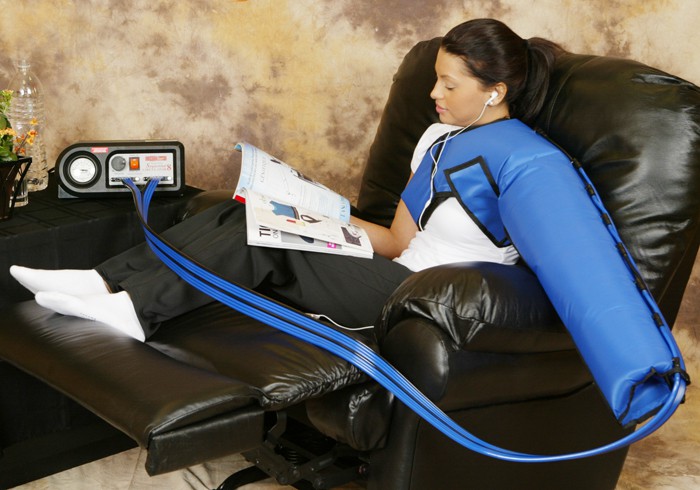Lymphedema occurs when there is a blockage in one or more of the lymph passages. These lymph vessels drain fluid from the tissues throughout the body and allow traffic of immune cells to travel where they are needed the most. The blockage of these vessels result in a condition where there is swelling in the tissues where there is no drainage that is occurring. One of the best methods of treatment for this condition is compression.
Compression in these affected areas was achieved with the use of multi layers of bandages. However, pressures were random and were hard to control. Over time, technology has developed better tools to aid those with this condition. Specialized clothing called compression stockings were developed to fit over limbs. These were effective to a degree but the pressure applied could still not be directly regulated and so these compression stockings were limited in their effectiveness. Nowadays, the best tool so far developed (asides from surgical methods ) is called the lymphedema pump. This specialized pump can apply regulated pressure to specific areas through a system of compressed and covered airbags that is fit over the affected area. In layman’s terms this is a high-tech compression stocking and it is far more effective than the traditional method of pressure through bandages or stockings. This type of treatment is called sequential pneumatic therapy and another application of this technology is the relief and accelerated recovery it offers from pulled hamstrings, painful joints, edemas or sprains.
If you or one of your loved ones is affected by this condition, and you’re in the market for a lymphedema pump, there are some things that you might want to consider before making your purchase. Read this basic guide and get a better understanding of the whats and whatchamacallits of this line of medical aids.
What are the components of a lymphedema pump?
A lymphedema pump, to be effective, is made of two basic units. The first part is the pneumatic compression device. This part is responsible for pumping air into the compression sleeve. The pressure at which it does this can be calibrated to the needs of a patient. Further, it has an automated cycle that has been pre-programmed into its system to maximize tissue drainage. The second part is the compression sleeve. This part is more specific to the needs of a patient. Specialized pressures sleeves have been designed such as Extremity sleeves, LymphaPants, LymphaJacket and new models such as the Comfy 1-75 for arm and torso therapy. A compression sleeve can have as many as 24 chambers. The sleeve is made of material that has been specially chosen to give comfort and it comes designed with a zipper so it can be conveniently put over the specific body part without difficulty or pain. The compression sleeve connects directly to the pneumatic compression device via a system of hoses that’s easy and hassle free to hook up to the pneumatic compression device.
What are the specifications of pneumatic compression pumps?
Different models of pneumatic compression pumps support 4 to 24 chambers and these pumps are programmed to mimic the lymphatic or arterial system of specific areas and move fluid in the correct physiological direction. The pressure applied to patients range from a gentle 25mmHg to a good 100mmHg. Pumps can be as light as 8 pounds or could weigh as much as 6.5 kilograms. The common pneumatic compression pump comes in 115 volt configuration.
Can I use a pneumatic compression pump for any of the sleeve designs?
There are different models of pneumatic compression devices and each has its features and limitations. You can connect a pneumatic compression pump to a sleeve design as long the specifications of the sleeve are met and you’ve consulted with one of the experts. Be sure to read the manual that comes along with a pneumatic compression pump to ensure proper function and care of your unit.
Are the compression sleeves easy to clean?
The compression sleeves have been designed with this thought in mind so as to promote good health and good skin care. Cleaning and maintenance of a sleeve is quick and easy.
Could you tell me more about the pain relief and accelerated recovery application of this technology?
Although this technology has been primarily developed for Lymphedema, research for new and practical applications are continually being done. One of these innovative applications called BioCyro gives patients cold, sequential pneumatic therapy to limbs suffering from pulled hamstrings, tendinitis, inflamed joints, edemas and all sorts of sprains. As you can clearly see, athletes can benefit greatly from this. They won’t only get relief from their pain but due to the accelerated blood flow and cooled down environment, they’ll also get accelerated healing and recovery.
One primary key why this treatment is so successful is that the compression sleeve has additional zip-on sleeves that can are stored in a freezer and when needed, can be applied to a problem area such as an ankle or a knee. This cold factor plus the sequential pneumatic therapy from the pneumatic compression pump gives you relief and recovery from traumas, muscoloskeletal and soft tissue pain and discomfort.
The comfort and relief you get from Lymphedema pumps and its other components are invaluable. Ensure a better and painless future by investing in the right equipment that fits your or your loved ones needs. Reading proper literature and consulting with the correct experts guarantees you the best results every time.
